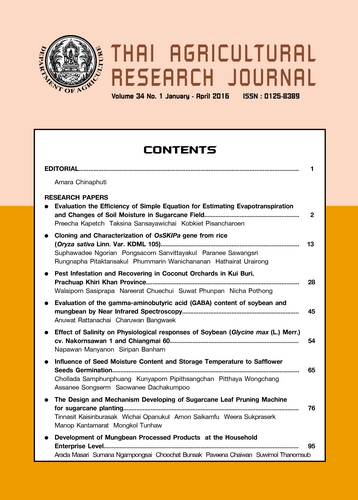Effect of Salinity on Physiological responses of Soybean (Glycine max (L.) Merr.) cv. Nakornsawan 1 and Chiangmai 60
DOI:
https://doi.org/10.14456/thaidoa-agres.2016.5Keywords:
soybean, salinity, proline, superoxide dismutase enzymeAbstract
This study aimed to determine the physiological response and growth of Nakhonsawan 1 and Chiangmai 60 soybean (Glycine max (L.) Merr.) grown under salinity. Soybeans were treated by nutrient solution supplemented with sodium chloride at 0, 40, 80, and 120 mM for 24 days. At the end of the experimental, root, shoot and leaf dry weight of the all treated soybean under higher salinity concentration significantly decreased when compared to the control. The dry weight of Chiangmai 60 under the salinity condition was higher than Nakhonsawan 1. The cultivars under higher salinity concentration tended to accumulate more proline and increased superoxide dismutase enzyme activity than the control group. However Nakhonsawan 1 exhibited more proline and higher superoxide dismutase enzyme activity than Chiangmai 60 under all salinity concentration.
Downloads
Published
How to Cite
Issue
Section
License
Copyright (c) 2017 วารสารวิชาการเกษตร (Thai Agricultural Research Journal)

This work is licensed under a Creative Commons Attribution-NonCommercial-NoDerivatives 4.0 International License.
Thai Agricultural Research Journal



